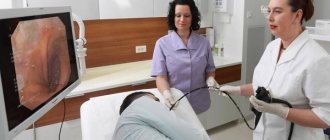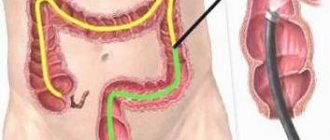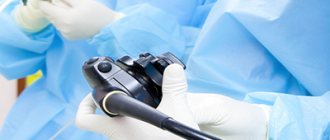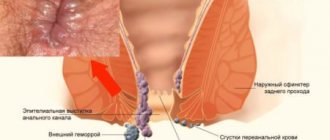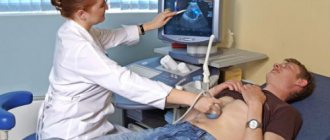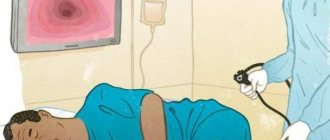Virtual colonoscopy is a new diagnostic method based on computed tomography or magnetic resonance imaging. It is designed to create a three-dimensional image of the inner lining of the colon. The method is used to diagnose precancerous diseases, including colon polyps, and colon cancer.
Virtual colonoscopy is also called computed tomography colonography, abbreviated as CCT (computed tomography of the colon). The possibilities of this diagnostic method are still being studied. Particular attention is required to determine the degree of accuracy of the results obtained in comparison with conventional colonoscopy.
In most cases, the CTC method is used in conjunction with other diagnostic methods, and it is chosen as an alternative diagnostic method if there are contraindications for colonoscopy or the patient is unwilling to perform it.
Indications for virtual colonoscopy.
Virtual colonoscopy is performed in the following situations:
- diagnosis of polyps and cancer of the colon, colon and rectum;
- observation for detected colon polyps (monitoring growth rates), as an alternative to endoscopic colonoscopy;
- monitoring the condition of patients after operations on the colon (polypectomy - removal of polyps, resection of the colon for cancer);
- diagnostic stage for suspected colon tumors obtained as a result of other methods of screening for colon cancer (fecal occult blood test, ultrasound of the abdominal cavity and pelvis);
- examination of the intestines when standard diagnostic methods are contraindicated (general diseases, intestinal obstruction), when the risk of endoscopic diagnosis is high.
Virtual colonoscopy can also be a diagnostically valuable test in some difficult clinical situations:
- establishing the causes and localization of the source of internal bleeding;
- establishing the causes of chronic diarrhea;
- observation during the treatment of inflammatory bowel diseases;
- diagnosis of diseases of various parts of the intestine.
November 15, 2022 Virtual colonoscopy is performed only after proper bowel cleansing. Such cleansing involves either cleansing alternating enemas the day before and on the day of the study, or the use of special pharmaceuticals, for example, Fortrans or Dufalak.
It is recommended to follow a diet two to three days before the procedure. To do this, you need to remove gas-forming foods and any solid foods from your diet. In general, the patient is recommended to consume exclusively liquid foods (tea, juices and compotes). When interviewed by a doctor, the patient must indicate a history of chronic diseases. Of particular importance is the pathology of the heart, kidneys, and liver. This should be warned before starting bowel preparation.
How is the research conducted?
As mentioned above, the method is based on X-rays.
The tissues of the human body pass them through themselves in different ways, which has long been used in medicine (X-rays). The denser the tissue, the less rays it transmits and the lighter it looks in photographs (bone), soft tissues such as muscle are gray, and lungs filled with air are black. When performing a tomographic colonoscopy, the device rotates around the patient, taking serial images from different angles. The rays passing through the human body are recorded by sensors and entered into a computer for processing. So one revolution around the body is called a “cut”. As a result, the photographs show a layer-by-layer pattern of the human body. The procedure itself takes little time, which mainly depends on how modern the device is used in clinics. For example, there are tomographs not with single, but with multiple sensors (about 40), which significantly increases the scanning speed. CT colonoscopy allows a computer to generate a 3D image of the colon cavity, and the specialist can change it, as if moving along the entire length of the large intestine.
Stages of the procedure.
The patient is asked to lie on his stomach.
A thin tube is inserted into the rectum, through which air is pumped. After this, the table on which the patient lies moves inside the scanner, where pictures are taken. Usually after this the patient is asked to turn on his back, and a number of more shots are taken. The whole process will take no more than 15 minutes. The procedure is absolutely painless, minimal discomfort is caused by the intestines distended with air. Next, the doctor describes the images; this takes no more than 30 minutes.
If the specialist detects some changes, the patient may be immediately referred for an endoscopic examination (polyps, tumor).
All information about the condition of the intestinal tube is saved on a digital medium, which is convenient when visiting the doctor again. Virtual colonoscopy (computed tomography of the intestine, CT colonography) is a new method of examining the colon, which allows one to assess the condition of the colon, abdominal organs and pelvis in one study.
Preparation for the procedure:
Diet
:
— 3 days before the test, exclude foods rich in fiber: vegetables and fruits in any form, grain and rye bread, cereals, legumes, cereals, sesame seeds, nuts, seeds and other small grains, seaweed, mushrooms.
- You can - eggs, cheese, milk and dairy products, meat, chicken, fish, a small amount of mashed potatoes and pasta.
— On the day of preparation for the study (i.e. on the eve of the study day): it is recommended to completely exclude food intake; before 16:00 you can drink 2-2.5 liters of clear liquid without pulp (clarified broth, sweet tea, clear juices without pulp and etc.).
— In the morning of the test day, do not eat, drink, or smoke.
REGARDLESS OF YOUR WEIGHT, DURING PREPARATION IT IS RECOMMENDED TO DRINK 4 LITERS OF THE PREPARATION
- Regimen for taking Fortrans if the test is in the morning:
The day before, from 16.00, you need to take 4 liters of solution (4 sachets of Fortrans) within 4 hours. Dissolve each sachet of the drug in 1 liter of drinking water. Take 1 liter of solution per 1 hour (i.e. 1 glass per 15 minutes) in small sips (not in one gulp!). At the very beginning of taking the drug solution or when taking it quickly in large quantities, nausea may occur. If it is difficult to take a solution of the drug due to its taste, you can add freshly squeezed lemon or other citrus juice to the solution, drink a small amount of sweet tea in between, and also suck barberry lollipops, honey, etc.
The test is scheduled until 12:00.
- Regimen for taking Fortrans if the study is during lunch:
on the eve of the study from 18:00 to 20:00, drink 2 liters of the drug, on the day of the study from 6:00 to 8:00, drink another 2 liters of the drug. Taking Fortrans should be completed at least 4 hours before the start of the study.
The test is scheduled after 12:00.
While taking Fortrans, it is recommended to move (walk, perform circular movements with the body, self-massage of the abdomen, etc.). At the end of taking the drug, the stool should change to a clear, colorless liquid. Defoamer ESPUMIZAN (emulsion!): with the last portion of Fortrans (in the last glass of Fortrans) in the evening and morning of the test day, take 4 scoops of Espumisan emulsion.
On the day after the study, if abdominal bloating persists, continue taking Espumisan 2 scoops up to 3 times a day. For chronic constipation - LAXATIVES of non-herbal origin - a week before the study (gutalax, dulcolax, laxylene, etc.).
Taking medications that normalize blood pressure, rhythm, etc. is mandatory in a standard manner! Antispasmodics: Buscopan 10 mg immediately before the study sublingually. Or Dicetel 50 mg, 1 tablet. x 3 times a day on the eve of the study, 1 tablet. 12 hours before the study.
Take with you: results of previous studies, a sheet.
How is CT colonography performed?
A CT scan of the intestine is performed after air is introduced through the patient's rectum, with the patient lying on his back and on his stomach.
The total duration of the study is 15-20 minutes. The procedure is well tolerated by patients; minimal discomfort in the form of a feeling of bloating is possible. After the examination, the radiologist, using special computer software, processes the data obtained, including obtaining three-dimensional images of the lumen of the colon (so-called virtual colonoscopy).
Radiation diagnostics department (MRI, CT, X-ray)
Registration for computed tomography of the intestine from Mon-Fri by phone: (3452) 29-41-43
How the research is carried out
A virtual colonoscopy is performed in the radiology department of a medical center or in specialized clinics. The study is carried out under the guidance of a radiologist who specializes in interpreting diagnostic results and an x-ray technician.
Before the procedure, the patient removes all clothing and puts on a loose shirt. After this, he can lie face up on the CT or MRI machine table. Further, the course of the procedure depends on what type of equipment the diagnostics is carried out on:
- when using a CT scanner, carbon dioxide is supplied to the intestines through a tube;
- When using magnetic resonance imaging, a contrast fluid is pumped into the intestine through a tube.
During the examination, you may need to hold your breath for a few seconds to prevent blurry or double images. If necessary, a repeat tomography is performed, during which the patient lies face down.
The average duration of a virtual colonoscopy is 10 minutes.
Computed tomography of the intestine: progress of the procedure
Immediately before the procedure, the patient is asked to remove all things, get rid of jewelry, watches, foreign objects, mobile phone, etc.
Then the subject is placed on the diagnostic table, the operator gives all the necessary instructions: take the required position (on the side, back, stomach). If necessary, to ensure the patient's immobility, which is necessary to obtain high-quality images, the limbs are fixed using special belts.
To perform a CT scan of the intestine, the rectum must be filled with carbon dioxide or air. For this purpose, a specialist inserts a thin tube into the patient’s anus, through which gas is injected using a bulb or pump. This event is necessary in order to maximally straighten the intestinal walls, which normally have bends and folds. Thanks to the “inflation” of the intestine, the view for the radiologist is improved and pathological processes in hidden areas are revealed.
After preparation, the patient is moved into the scanner itself, asked to hold his breath and change his body position for the next sections.
The CT scan takes an average of 15 minutes, after which the specialist removes the gas tube and allows the patient to stand up.
Advantages and disadvantages of the method
Compared to standard video colonoscopy, virtual colonoscopy has a number of advantages and disadvantages. The advantages of this method include:
- less traumatic, lower risk of complications compared to endoscopic examination;
- no need to use sedatives or anesthetics - after the study, the patient can return to normal life;
- the ability to examine all parts of the intestine even in the presence of obstruction.
In addition to all of the above, the method of introducing air or a contrast agent into the intestines is also considered an advantage. This is done using a very thin and short tube that is inserted into the rectum and not into other parts of the intestine.
Among the disadvantages of virtual colonoscopy are:
- difficulties in diagnosing polyps less than 10 mm in diameter;
- inability to perform tissue biopsy during the study.
- the need for endoscopic colonoscopy after detection of tumors in the intestine by this method for the purpose of biopsy from a tumor or polyp and subsequent histological examination;
In addition, virtual colonoscopy is one of the less common procedures, so it is not available in all clinics.
Preparing for a CT scan of the intestines
Three days before the test, you should remove toxins and gas-forming products from your diet. In one day you are allowed to eat only liquid soups. The night before, you should cleanse your intestines with specialized laxative medications.
You need to avoid drinking alcohol for at least three days. On the day of the examination, you cannot eat; you are allowed to drink a small amount of still water.
To perform a contrast colonoscopy, you will need to drink a radiocontrast drug before the procedure.
What you need to know about this diagnostic method
Virtual colonoscopy may be performed on patients who are at moderate risk of colorectal cancer or to screen for colon cancer. If the risk of colorectal cancer is high, endoscopic colonoscopy is preferable because it can remove the polyp or take a biopsy from the polyp or tumor.
You need to prepare for a virtual colonoscopy in the same way as for a regular one. If abnormalities are detected, additional diagnostics may be required, usually video colonoscopy.
Virtual colonoscopy is not available in all medical institutions, as it requires special equipment. In addition, trained professionals are needed to interpret the study results. In some cases, colonoscopy results may vary depending on the experience of the doctor and the equipment used.
A virtual colonoscopy is performed to clarify the diagnosis made during a regular colonoscopy. It is also more often used to examine people at average risk of colon cancer, or for screening.
Virtual colonoscopy is certainly a promising method for diagnosing and screening intestinal diseases; the study of all the possibilities of this method has not yet been completed.
Diet before colonoscopy
Before a colonoscopy you can eat:
- Boiled or steamed meat: chicken, fish, lean beef.
- Low-fat broth;
- Eggs;
- Boiled sausage;
- Cheese;
- Fermented milk products without additives (kefir, fermented baked milk);
- Unsweetened cookies;
- White bread.
Before a colonoscopy you should not eat:
- Legumes (beans, peas, soybeans, lentils);
- Vegetables (potatoes, cabbage, radishes, radishes, beets, carrots, turnips, garlic, onions);
- Sorrel and spinach;
- Fruits (apricots, plums, peaches, pears, dates, bananas, oranges, tangerines, raisins, grapes);
- Nuts and berries (currants, gooseberries, raspberries);
- Brown bread (including grain bread);
- Porridges made from pearl barley, millet, buckwheat and oatmeal.
Before a colonoscopy you should not drink:
- Milk;
- Alcohol;
- Carbonated drinks.
What is CT colonoscopy?
Computed tomography (CT) is a non-invasive test that allows doctors to look “inside” a patient’s body.
A tomograph (a special X-ray machine) receives a large number of images (so-called slices), which are processed by a computer and displayed on a monitor screen or printer.
Computed tomography provides high-quality images of many internal organs, bones and blood vessels.
Virtual colonoscopy is a special type of computed tomography that examines the large intestine (colon - in Latin). Conventional colonoscopy (not virtual) is an endoscopic diagnostic method in which the endoscope is inserted directly into the colon.
Will this method replace the classic colonoscopy?
Colonoscopy is an important diagnostic procedure related to endoscopic examinations. The essence of the examination is to insert a special colonoscope equipped with a camera through the anus into the large intestine. As it moves through the intestinal loops, which are straightened by air, an image of their inner mucous membrane is displayed on the monitor. This procedure may cause discomfort and in this case it can be carried out in a state of medicated sleep. In addition, there are a number of absolute and relative contraindications to colonoscopy. Therefore, relatively recently an alternative method of examining the intestines has appeared - virtual colonoscopy.

